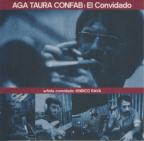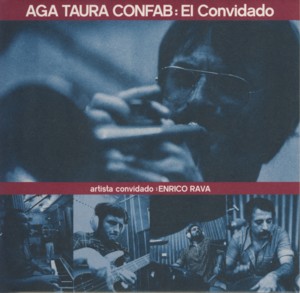Record Reviews
1 Review Found. Use search to find more reviews or follow the links in the review text.
  | AGA TAURA CONFAB / ENRICO RAVA ~ EL CONVIDADO
SVART / MONDO 381 (Barcode: 6430065589419) ~ ARGENTINA ~ Jazz-World Fusion
Recorded: 1975 Released: 2019
In June of 1975 Italian trumpeter / composer Enrico RavaFind albums by this artist recorded his debut album for the prestigious German ECMFind albums on this label label, entitled "The Pilgrim And The StarsFind albums with this title", which upon its release later that year kick-started his solo career. The album was recorded with an international lineup of ECM stable musicians: American guitarists John AbercrombieFind albums by this artist (who also released his ECM debut the same year) and a marvelous Scandinavian rhythm section consisting of Swedish bassist Palle DanielssonFind albums by this artist and Norwegian drummer Jon ChristensenFind albums by this artist.
A trumpet virtuoso and an exceptionally gifted composer, Rava established himself on the international scene during the entire decade earlier, playing and recording with the elite of Avant-Garde Jazz players of that period both in Europe and in America, which included Steve LacyFind albums by this artist, Roswell RuddFind albums by this artist, Charlie HadenFind albums by this artist, Don CherryFind albums by this artist, Argentinean Gato BarbieriFind albums by this artist (during his stint in Italy), Lee KonitzFind albums by this artist and others. By the early 1970s Rava embraced a more melodic approach to Jazz and started to cooperate with Fusion musicians, a path common to many of his European contemporaries. This led to his participation in the recording of the seminal Jazz-Rock opera "Escalator Over The HillFind albums with this title" by Carla BleyFind albums by this artist as well as the recording of the little known album for the legendary German MPSFind albums on this label label called "Katcharpari RavaFind albums with this title", where he played vis-à-vis Abercrombie and which, when first heard by ECM owner Manfred EicherFind albums by this artist, led to inviting them both to record for ECM in the first place.
What led Enrico Rava to take part in the recording of the obscure album you are holding in your hand, which took place in December of 1975 in Buenos Aires, the Capital of Argentina, you ask? Well it turns out Rava had some family in Buenos Aires, which he was visiting at the time and which is hardly surprising considering the fact that most of Argentina´s inhabitants are descendants of European ethnic groups, with more than 55% of them having Italian origins. Therefore being Italian and having family in Argentina is a highly probable outcome. Quite accidently, Rava already visited Buenos Aires almost a decade earlier, when playing there with the Steve Lacy quartet. A performance by that quartet recorded in Buenos Aires in November of 1966 was released as the album "The Forest And The ZooFind albums with this title" on the ESPFind albums on this label label.
The rest of the story, however, is pure Jazz "improvisation". Upon learning that Rava is in town, local Jazz aficionados swiftly decided to size the day and hook him up with local musician and record an album. It is difficult to know today if Rava and the Argentineans realized that he was already under ECM contract and they needed to ask Eicher to give them permission to make this recording, which was highly unlikely he would. But considering South American attitude towards rules and regulations nobody probably cared too much about it, which of course in retrospect should make us thankful.
The team selected to accompany Rava, named as "Aga Taura ConfabFind albums by this artist", included three Argentinean Jazz musicians: pianist Fernando GelbardFind albums by this artist, bassist Adalberto CevascoFind albums by this artist and drummer Nestor AstaritaFind albums by this artist and an Argentinean Folk percussionist Farias GómezFind albums by this artist, who also contributed vocalese parts. Although less experienced and with no international exposure at the time, they stood their ground formidably and performed alongside Rava without any inferiority complex. Of the five tunes on the album, four are performed by the quintet, where Gelbard plays the Fender Rhodes electric piano, and one is a duet consisting of Rava and Gelbard, who plays acoustic piano. Not surprisingly Rava´s performances are the absolute pinnacle of the session, encompassing different styles and approaches moving between melodic lyricism and Free Form explorations. He knowingly pays tribute to his idols: Miles Davis and Chet Baker, but avoids copying any explicit phrasing and crafts his distinctly own voice.
The spontaneous recording session lasted for a few hours, just long enough to capture five tracks totaling in about forty two minutes of music. The sound quality of the recording turned out to be better than one might expect, with clear, crispy tone and excellent separation, which suited the music perfectly. The music includes a Rava original, which appears only on this album, a standard, a composition by the Brazilian composer João DonatoFind albums by this artist, a composition by Argentinean saxophonist / composer Horacio BorraroFind albums by this artist and finally a composition by the quintet´s percussionist Farias Gómez a mixed bag which offers a strong World Music influence and plenty of opportunities for the musicians to show their chops.
In retrospect this is definitely a piece of music that deserves to be revisited, not only for nostalgic reasons, but primarily as a historical document of the period, as well as proof of the fact that music knows no boundaries. Due to its rarity the original LP release is a highly sought after collectors item to Jazz aficionados all over the world, not only connoisseurs of Enrico Rava, but also enthusiasts of early Jazz-World Fusion.
Side Note
The above are my liner notes included on this album's artwork.
I am honored when asked by the Artists to write liner notes for their albums, always hoping that my words reflect the true spirit of the music. This is also a symbol of our mutual respect and friendship developed over the years.
The same is also true when Record Labels ask me to write liner notes for their releases, mostly in the case of reissues of archival albums, which is a symbol of their appreciation of my knowledge and historical perspective and my recognition of their dedication to the preservation of the history of recorded music and the effort to keep human Culture and Aesthetics alive.
| | Updated: 22/05/2020Posted: 22/05/2020 | CD 1 Mini-Sleeve Remastered Recommend To A Friend |
|







